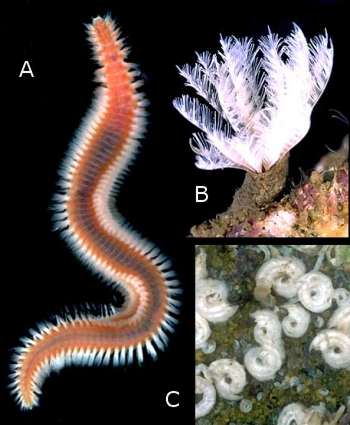
Polychaete Worms (Bristle worms)
Polychaete worms are closely related to leeches and earthworms and together make up the Phylum ANNELIDA. Polychaetes are often called bristleworms because each of the body segments has an upper and lower bundle of bristles (called setae or chaetae) on each side. In free-living polychaetes, the bristles, combined with snake-like body waves, help the worm to move along. In Fireworms, Eurythoe spp (A), the bristles have evolved into defensive organs. They are fragile, hollow tubes filled with poison. They are easily broken when the worm is touched and the pain they cause when they pierce the skin makes their common name very appropriate.
The bristles found in worms that live in tubes or burrows (sessile or sedentary worms) have often evolved into hooks to help anchor the worm in place. Sedentary worms make a whole variety of homes. Many make a hard calcareous tube (C - Spirorbis), which is attached to a hard surface or even large algae. Other sedentary worms have a leathery tube, sometimes decorated with pieces of broken shell, or sand and mud particles.
Free-living worms include carnivores, herbivores and scavengers. Some, such as the fireworms, are active carnivores feeding on colonial animals eg: sponges and ascidians). On the other hand, sedentary worms, (which cannot move about), usually feed on microscopic plants and animals or fine particles. Many sedentary worms filter plankton out of the water by a crown of feathery tentacles that surround their mouth and give them their common name of 'fanworm' or 'feather duster' worm (B).
Worm is a common name which applies to a 'shape' rather than a particular phylum or class of animals, much as 'slug' applies to much more than opisthorbanch molluscs. There are a few slug-like worms, such as Aphrodite which are sometimes mistaken for sea slugs.
Authorship detailsRudman, W.B., 2004 (July 27) Polychaete Worms (Bristle worms). [In] Sea Slug Forum. Australian Museum, Sydney. Available from http://www.seaslugforum.net/find/polychaete
Related messages
Re: Sea Mouse from South Australia
November 2, 2007
From: Duncan Gunstone
Concerning message #20284:
Hi Judith and Bill,
Thanks for your messages and great photos -- my wife and I have also spotted a sea mouse, again barely alive, this time in a shallow rock pool on Trigg beach in Perth, WA.
Locality: Perth , 3 inches / 9 centimetres, Western Australia, Trigg Beach, Inian Ocean, 23 October 2007, shallow rock pool with sandy bottom on beach. Length: 6 inches/ 15 cms. Photographer: none - DOH!.
About the size of a man's hand, with ribs underneath, like a woodlouse, and with a hariy top. We're kicking ourselves now for not taking photos -- as everyone we asked has been sceptical of our sanity.
Amazing creatures, and quite rare, so we are well-chuffed to have sighted one!
Duncan Gunstone
duncangunstone@hotmail.com
Gunstone, D., 2007 (Nov 2) Re: Sea Mouse from South Australia. [Message in] Sea Slug Forum. Australian Museum, Sydney. Available from http://www.seaslugforum.net/find/21016Dear Duncan,
You were lucky the sea mouse was one of the few non-slug animals which has ended up of the Forum. Glad we could be of help
Best wishes,
Bill Rudman
Re: Sea Mouse from South Australia
July 23, 2007
From: Judith Jones
Concerning message #20253:
Thank you for taking the time and trouble to help us on our way.
I appreciate it.
Judith
judithjones@hotmail.com
Jones, J., 2007 (Jul 23) Re: Sea Mouse from South Australia. [Message in] Sea Slug Forum. Australian Museum, Sydney. Available from http://www.seaslugforum.net/find/20284Sea Mouse from South Australia
July 20, 2007
From: Judith Jones
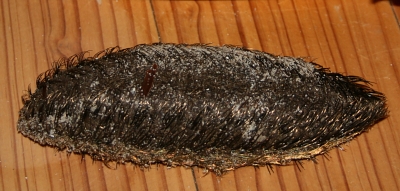
Hello,
This photo is of one of two identical creatures found barely alive, washed up on Antechamber Bay at the Eastern end of Kangaroo Island, South Australia.
They were found on 17th July 2007, a week or so after several days of storms and strong winds had ceased and were followed by calm weather. We only have general books and are amateurs, so beyond "guessing" at sea cucumber, we do not have any other ideas.
http://www.flickr.com/photos/justjjoke/843568587/
Locality: Lashmar Conservation Park, Kangaroo Island, South Australia, washed ashore, Australia, Antechamber Bay, 17th July 2007, high tide line. Length: 4.5 inches or 11cms (approx). Photographer: Judith Jones.
Thank you for any assistance you might be able to offer.
Judith
judithjones@hotmail.com
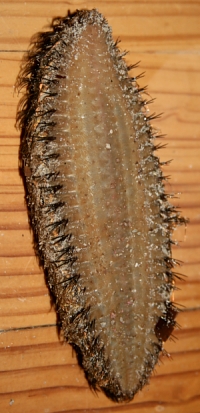
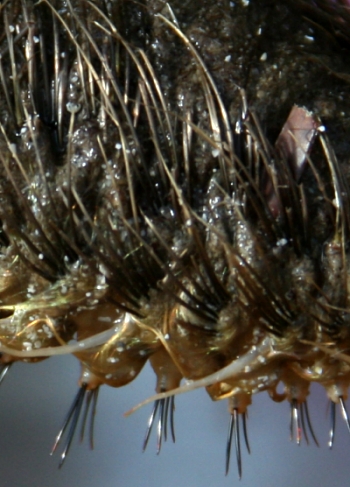
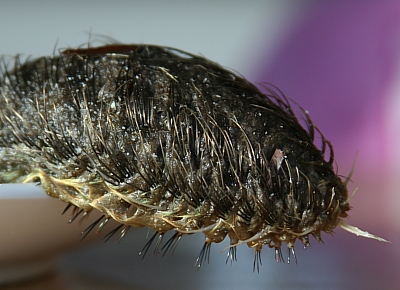
Dear Judith,
This is not a sea cucumber, and definitely no a sea slug, so by my own rules I shouldn't spend time on it. However it is a fasciinating animal and you have some good photos.
It is a specialised polychaete worm and the bristles you can see [setae, chetae] are where these segmented bristle worms got their name [poly = many; chetae = bristles] as distjnct froom the earthworms or oligochaetes [oligo = few]. Your worm is a member of the family Aphroditidae and animals are commonly called 'Sea Mouse' for fairly obvious reasons. The most wellknown genus is Aphrodita which has often been mispelled Aphrodite. There a species worldwide as you can see in Clinton Bauder's photo [#7171] from California. There are a number of species described from Australia. I hope this is enough information for you to look for more, but as much as I would like to, I haven't the time to become a site for all interesting marine life.
Best wishes,
Bill Rudman
Purple Snake-thing from Alaska
July 9, 2007
From: Melissa Brook Steward
Hello,
My name is Melissa Steward, and I live in Klawock, Alaska. I was out canoeing one evening right near the shore, and I saw a 14-inch, purple snake-type thing swimming on the surface of the water. As I looked around, I saw there were more of them, all swimming quite fast upon the surface. They were bright purple, had heads just like a snake, long, slender flat bodies, and little tiny hairs or legs lining both sides of their bodies. It looked like it had the texture of a sunfish, all soft and squishy, on the top, but I didn't get to see its underside. Can you tell me what this is? I have looked up every kind of marine worm, eel, slug, nudibranch... that I could find, and none of them looked like what I saw.
Locality: Big Salt Lake Channel, Klawock, Prince of Wales Island , 15-25 feet, Alaska, USA, Pacific, 15 June 2006, rocky shoreline, salt water, fairly clear. Length: 12-14 inches. No photo.
Melissa
melissasteward@gmail.com
Steward, M.B., 2007 (Jul 9) Purple Snake-thing from Alaska. [Message in] Sea Slug Forum. Australian Museum, Sydney. Available from http://www.seaslugforum.net/find/20124Dear Melissa,
What you have described is most certainly polychaete worm. Paging through Lamb & Hanby (2005) the NW Pacific invertebrate Bible, there are two species that can be purple and reach a foot in length. These would be Hololepida mana, the Giant Fleshy Scaleworm, and Nephtys sp., the Goddess Worm.
Hope this helps,
Dave Behrens
Sting on my finger from Florida
July 2, 2007
From: Jason Horn
Concerning message #19991:
I just was out body surfing in north east florida and felt a piercing sting on my left pinky finger. I looked down and saw what appeared to be a bandaid looking thing on my finger I swiped it off and saw what looked like an orange worm with little legs all along it like a centipede of the sea. It still hurts and my friends thought I was crazy saying it must have been a man o war but I was sure and did a google search and it brought me here. How it ended up on my finger in the surf is news to me. But I'm glad it's not deadly!
Locality: Atlantic Beach, 5 feet , FL, US, Atlantic , 30 June 2007, surf zone. Length: a couple inches?. Photographer: a picture in my mind and sting on my finger.
Thanks for the info!
Jason
hornjason15@yahoo.com
Horn, J., 2007 (Jul 2) Sting on my finger from Florida. [Message in] Sea Slug Forum. Australian Museum, Sydney. Available from http://www.seaslugforum.net/find/20090Dear Jason,
I can't claim to be a worm expert but I am glad we could help solve your mystery.
Best wishes,
Bill Rudman
Re: Today's mystery guest from Sulawesi
June 22, 2007
From: Leslie Harris
Concerning message #19380:
Hi Bill & Ken --
This is indeed a polychaete and a scaleworm in the family Polynoidae although I'm not convinced it's the anterior end. It is gorgeous - I've never seen that color before in a worm. The overlapping elytra (= scales) that account for the common name are most noticeable along the right side of the body. With it's inflated dorsal cirri (the club-shaped appendages) and the large macropapillae on the elytra it might be in the genus Asterophilia. The two described species are obligate commensals on echinoderms so this one's location on a muck bottom would be most unusual for the genus.
Cheers,
Leslie
lharris@nhm.org
Harris, L.H., 2007 (Jun 22) Re: Today's mystery guest from Sulawesi. [Message in] Sea Slug Forum. Australian Museum, Sydney. Available from http://www.seaslugforum.net/find/19991Thanks Leslie,
I appreciate your efforts to educate us molluscophiles
Best wishes,
Bill Rudman
Today's mystery guest from Sulawesi
June 5, 2007
From: Ken Tucker
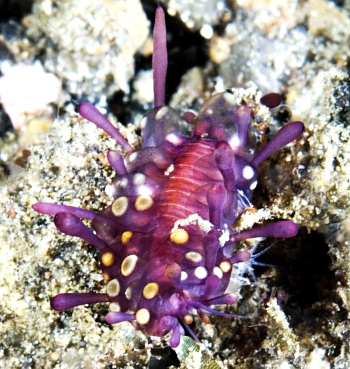
I cannot even hazard a guess as to what this might be. Perhaps someone can shed some light on the subject.
Locality: Jahir, Lembeh Strait, 8 metres, Indonesia, Sulawesi, 21 Nov 2006. Length: 1 - 1.5 cm. Photographer: Ken Tucker.
Ken Tucker
ken@kilili.com
Tucker, K., 2007 (Jun 5) Today's mystery guest from Sulawesi. [Message in] Sea Slug Forum. Australian Museum, Sydney. Available from http://www.seaslugforum.net/find/19380Dear Ken,
I am pretty sure this is the head - or front end - of a polychaete worm. The rest of the animal is in a crevice or burrow. I don't recognise the species but the clear segments you can see are typical of this phylum of worms which are sometimes called 'segmented worms'.
Best wishes,
Bill Rudman
Re: Giant nudibranch? off Vancouver Island, Canada
August 5, 2006
From: Leslie Harris
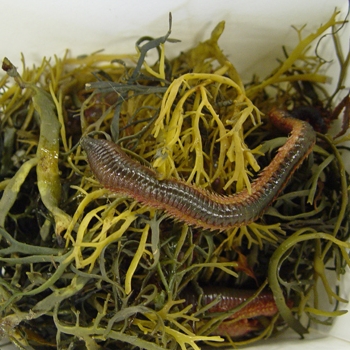
Concerning message #17070:
I'm quite sure from your description that it's a large nereid polychaete. At that size it's almost certain to be Neanthes brandti or N. virens (some taxonomists put them in the genus Nereis). These can reach nearly 3 feet in length. Normally they're bottom dwellers but will swim to both hunt and spawn. The image shows east coast N. virens I purchased in a bait shop in Bodega Bay, California.
Locality: Bodega Bay, California, North Pacific, September 2003, sold in bait shop. Length: 12 inches. Photographer: Leslie Harris.
Cordially,
Leslie Harris
lharris@nhm.org
Harris, L.H., 2006 (Aug 5) Re: Giant nudibranch? off Vancouver Island, Canada. [Message in] Sea Slug Forum. Australian Museum, Sydney. Available from http://www.seaslugforum.net/find/17330Thanks Leslie,
Bill Rudman
Giant nudibranch? off Vancouver Island, Canada
August 4, 2006
From: Don Belke
My friends and I were anchored in a bay in 45' of water about 30 miles west of Belle Coola, British Columbia. This bay was also 30 miles from open ocean north of Vancouver Island.
Around 5 pm on June 17, 2006, I saw a eel/snake looking creature swimming just under the boat. It was close to 1 meter long appeared somewhat flat, about 4" wide all along its length, it as olive green with dirty yellow boarder that surrounded the entire body that resembled tassles on a rug. WE couldn't believe our eyes.By the way I couldn't see eyes on it either. Is it a nudibranch or sea monster?
Don Belke
dbelke@shaw.ca
Belke, D.G.S., 2006 (Aug 4) Giant nudibranch? off Vancouver Island, Canada. [Message in] Sea Slug Forum. Australian Museum, Sydney. Available from http://www.seaslugforum.net/find/17070Hi Don,
Based on your description I think your critter was a polychaete worm, rather than a sea slug. I just reviewed Andy Lamb's new book, Marine Life of the Pacific Northwest, and there are a couple that could be yours.
-
Lamb, A. & B. Hanby. 2005. Marine Life of the Pacific Northwest - A photograhic encyclopedia of invertebrates, seaweeds and selected fishes. Harbour Publishing.
Best wishes,
Dave Behrens
Re: 'Sea Mouse' from England
January 14, 2006
From: Sally Elizabeth Moore
Concerning message #15544:
Thank you so much-! Yes that is what it was. I am delighted to know and will know try to learn more about them.
Sally
sally@sallymoore.co.uk
Moore, S.E., 2006 (Jan 14) Re: 'Sea Mouse' from England. [Message in] Sea Slug Forum. Australian Museum, Sydney. Available from http://www.seaslugforum.net/find/15548'Sea Mouse' from England
January 13, 2006
From: Sally Elizabeth Moore
I have just been walking my dog on the sand at Exmouth in England in the estuary . I came across a creature about 4-5 inches long lying on the sand. I assumed it was dead as it was upside down. But it moved when I touched it. The underside was ribbed rather woodlouse like in appearance. When I turned it over the centre of its back was covered in sand . Then it appeared to have black spines and finally the most wonderful iridescent coloured hairs along its sides. I picked it up (using a polythene bag in case it was poisonous ) and put it in some shallow water. At first it did not appear to move but then I realised it was somehow disappearing into the sand. I know nothing about sea creatures but was fascinated by this one. So when I came home I googled sea slug because that was the nearest thing I could think of and came across this site. I hope someone can tell me what it was so that I can learn more!
Sally Moore
sally@sallymoore.co.uk
Moore, S.E., 2006 (Jan 13) 'Sea Mouse' from England. [Message in] Sea Slug Forum. Australian Museum, Sydney. Available from http://www.seaslugforum.net/find/15544Dear Sally,
From your good description I can give you a quick answer. It is not a sea slug but a type of polychaete worm which is often called a Sea Mouse. Have a look at the photos of one from California [message #7171]. One genus name is Aphrodite so that's a good name to search for on the web.
Best wishes,
Bill Rudman
Nudibranch ? from North Carolina
July 4, 2005
From: Robert Todd
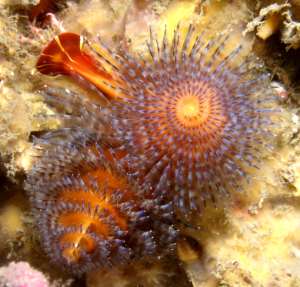
I noticed the orange and yellow organism behind the Christmas Tree Worm in the attached photo after I surfaced. Can someone identify the species? The photo was taken at about 24 meters depth, on a WWII wreck just east of Cape Lookout, North Carolina, US.
Locality: Wreck of Caribe Sea. North Carolina, USA. Atlantic Ocean. Depth: 24 meters. Length: Approx. 3 cm. 18 June 2005. Photographer: Robert Todd
Thanks!
Robert Todd
robert_todd@hotmail.com
Todd, R.E., 2005 (Jul 4) Nudibranch ? from North Carolina. [Message in] Sea Slug Forum. Australian Museum, Sydney. Available from http://www.seaslugforum.net/find/14170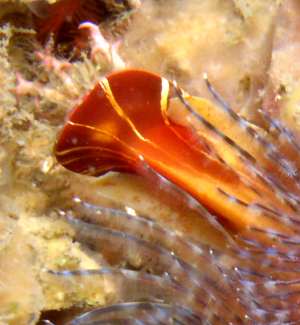
Dear Robert,
The Christmas Tree Worm, Spirobranchus, belongs to the polychaete worm family Serpulidae. Serpulid worms live in a calcareous tube and all we normalyy see of them is the feeding and breathing 'feather duster' they display. This delicate and vital part of the wroms anatomy is rapidly withdrawn when the worm is startled and the worm's tube is protected by a door [operculum] which tightly closes after the feather duster withdraws. What you think may be a slug is the stalk and operculum of the worm. There are some pinkish white hook-like structures at the flattened end. These are spines on the operculum which face out when the 'door' is shut. The decoration on the operculum differs between species.
Best wishes,
Bill Rudman
Sea Mouse from Lancashire?
May 28, 2003
From: David Hulston
Hello sea slug people
Just got in from trip to Lancashire, England coastline where my daughter and I saw the wierdest of things, can you i.d for us? it was slug like, about 6 inches long but very broad and flanked with rich copper coloured coarse hair. it's underside was lined with 2 rows of sucker like feet a very beautiful but strange creature i have never seen in all my years walking on the coast of England.
Look forward to your reply
David Hulston
dhulston41@hotmail.com
Hulston, D., 2003 (May 28) Sea Mouse from Lancashire?. [Message in] Sea Slug Forum. Australian Museum, Sydney. Available from http://www.seaslugforum.net/find/10062Dear David,
Sounds like a 'Sea Mouse' which, despite its common name, is a very specialised marine worm. Have a look at the Clinton Bauder's photo of an animal from California which looks quite similar to the European species. Definitely not a slug. Let me know if I'm wrong and I'll have another think
Best wishes,
Bill Rudman
Re: Spiny mystery from Ireland
January 9, 2003
From: Cian Murphy
Bill,
Thanks for your response to my query regarding my spiny sea-slug. You were exactly spot on in your opinion that it was in fact a sea mouse, an animal I had never previously heard of. I've done a bit of reading on sea mice and they appear to be fascinating animals.
Many thanks once again!
Cian
cian.murphy@kpmg.ie
Murphy, C., 2003 (Jan 9) Re: Spiny mystery from Ireland . [Message in] Sea Slug Forum. Australian Museum, Sydney. Available from http://www.seaslugforum.net/find/8875Spiny mystery from Ireland
December 23, 2002
From: Cian Murphy
To whom it may concern,
I am an extreme amateur at the art of identification and marine biology in general, however I am very interested in species I come across on shores and rock pools all over Ireland. Recently whilst walking on Bull Island Strand, Dublin at low tide (sandy beach) I came across what upon further research appears to have been an Aeolidia papillosa. The specimen was around 4/5 inches long with a flat smooth back and a dense almost 'dog like' covering of hair on its sides. What threw me off a positive ID were the apparent bristles/spines that were present in clusters along both sides of the animal. The spines (which felt like hard bristles on a brush) seemed to emerge from nodules right the way along each side of the animal. I have been reliable informed that sea-slugs don't have spines so hence my confusion. The animal was alive and spurted a brownish liquid at me when I pick it up. Could it be that the animal was sick and its feelers (to put it in a extremely non-scientific way) were decomposing? Any comments would be greatfully appreciated.
Thanks
Cian Murphy
cian.murphy@kpmg.ie
Dear Sian,
It is difficult without an illustration to be sure, but an animal with the look of Aeolidia papillosa, but 'bristles/spines' in clusters, suggests to me you may have a sea mouse, which is a specialised kind of polychaete worm. Have a look at Clinton Bauder's message which has a couple of photos of a Californian species of sa mouse. One common genus is Aphrodite, so you could check on the web, or in books, for further illustrations.
Best wishes,
Bill Rudman
Re: hairy worm from Brisbane
June 5, 2002
From: Chris Glasby
Kerri is very likely to be correct about calling the creature fished from the Brisbane River a 'worm'. Polychaete worms are occasionally caught by fishers the world over, and in this case the species is probably Chloeia flava, an amphinomid, or fireworm, named for the intense sting one would get by touching the bristles on its sides. The fur on the upper surface referred to by Kerri is most likely the elaborate branchiae.
To learn more about this creature and other bait-taking polychaetes please consult • Glasby, C.J. & Bailey-Brock, J. 2001. Bait-taking fireworms (Amphinomidae: Polychaeta) and other polychaetes. The Beagle, Records of the Museums and Art Galleries of the Northern Territory, 17: 37-41.
Thanks to Richard Willan for bringing this query to my attention
Chris Glasby
chris.glasby@nt.gov.au
Glasby, C., 2002 (Jun 5) Re: hairy worm from Brisbane. [Message in] Sea Slug Forum. Australian Museum, Sydney. Available from http://www.seaslugforum.net/find/7147Thanks Chris,
I must say my first thought was a worm such as Aphrodite, as suggested by Clinton Bauder, but I thought the easiest approach was to eliminate the 'slug' possibility which Kerri has done in her second message. I agree that a 'fireworm' is a most likely answer.
Cheers,
Bill Rudman
Re: Hairy 'worm' from Brisbane
June 5, 2002
From: Kerri
Hi Bill,
Thanks for replying so quickly to my "hairy worm " query!! I've had a look at the Sea Hares but they're not the ones!! I've no idea why i'm so facinated with them (morbid curiosity perhaps) but I'll try again.
When I mentioned a segmented body I should have said the underbelly looked like a witchety grub. We were near a rock wall in about 4 metres of water. The bottom was a sludgy sand /mud mixture but there were mangroves nearby. We were getting a lot of small bream on our lines, but they weren't interested in eating the hairy worms either. When we tried to get the "hairy worms" off the lines they curled up into a ball like an echidna, hairy bit outwards. Hope you can help
Kerri
kerrilambert@optusnet.com.au
Lambert, K., 2002 (Jun 5) Re: Hairy 'worm' from Brisbane. [Message in] Sea Slug Forum. Australian Museum, Sydney. Available from http://www.seaslugforum.net/find/7161Dear Kerri,
Since posting your message I have had a couple of messages [one from Darwin and one from California suggesting you furry animals are indeed worms - polychaete worms, a suggestion which I fully agree with. As a fisherperson I am sure you are familiar with segmented 'beachworms' which are a much more elongate version of a 'polychaete worm' than the ones you encountered in the Brisbane River.
Cheers,
Bill Rudman
Re: Hairy 'worm' from Brisbane
June 5, 2002
From: Clinton Bauder
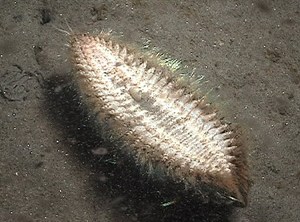
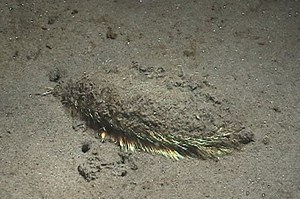
Hi Bill,
I suspect Kerri's animal may be a "sea mouse" which is a kind of polychaete worm. Unlike a Sea Hare they would have a segmented body. Here are some pictures of an animal from California. I'm told similar species exist in many other places in the world.
Clinton
gecko1@apple.com
Bauder, C., 2002 (Jun 5) Re: Hairy 'worm' from Brisbane. [Message in] Sea Slug Forum. Australian Museum, Sydney. Available from http://www.seaslugforum.net/find/7171Thanks Clinton,
Now that Kerri's second message has eliminated a 'slug' as the, your polychaete suggestion is certainly the most likely answer. Your message nicely illustrates the message from Chris Glasby also suggesting this could be a polychaete worm. He suggests another family of polychaetes, the fireworms. At the risk of starting a 'worm thread' in the Sea Slug Forum, I am not sure whether sea mice, such as you illustrate, are very common anywhere in Australian waters
Best wishes,
Bill Rudman
Hairy 'worm' from Brisbane
June 2, 2002
From: Kerri
Hi,
I was wondering if you could tell me what kind of worm,slug type creature we came across in the Brisbane river is. [Brisbane, Queensland, Australia] Unfortunately I do not have a photo, but I'm assuming they are either an introduced species that has flourished or we just happened on a large population of them. They were about 5-6cm in length with what appeared to be fur growing over the top half of them. Their underbelly was segmentd similar to a large garden grub which was pinkish in colour. The fur on top of them was light grey in colour and about 1cm long. We were fishing near a rock wall and they kept getting onto our hooks!! Thanks...
Kerri
kerrilambert@optusnet.com.au
Kerri, 2002 (Jun 2) Hairy 'worm' from Brisbane. [Message in] Sea Slug Forum. Australian Museum, Sydney. Available from http://www.seaslugforum.net/find/7144Dear Kerri,
At this stage I'll ignore your description of a 'segmented underbelly'. I suspect what you found is a Sea Hare called Bursatella leachii. Its about the size you describe, and often very furry, except for the smooth sole of its foot which can have transverse wrinkles when picked up, which could be mistaken for segments. You don't mention if any of them squirted red or purple ink when snagged by your fish hooks - they tend to do this when irritated.
Have a look at the page on Bursatella and the other messages and photos about and let me know if that is what upset your fishing. If it is, then Sea Hares are sometimes found in these big populations and then not seen again at a particular place for many years.
Best wishes,
Bill Rudman
